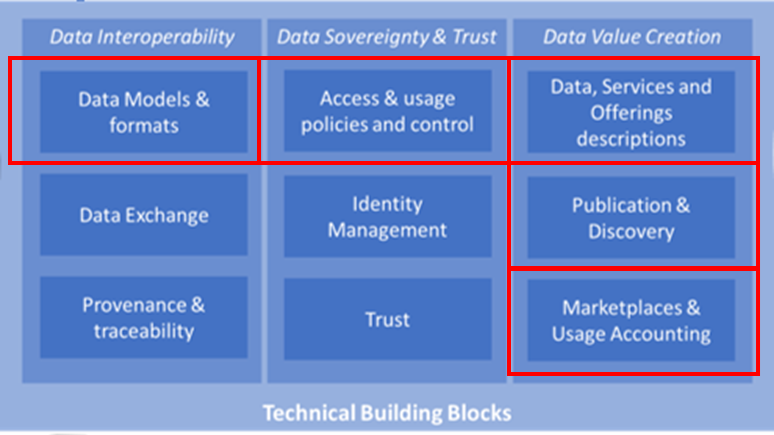FOR SHARE - JULY SNAPSHOT - Publication and Discovery services - Two pages description
Early draft
Please be aware that the Data Spaces Blueprint content shared in these pages are a very early draft published on 2023-07-01. The current draft is incomplete and the content might still change.
SAVE-THE-DATE 01-10/09/2023: We will welcome your feedbacks to future improve the Data Spaces Blueprint during the Public consultation that will open on September the 1st 2023 until September the 10th. Please mark these dates in your calendar and get ready!
Overview
A Data Space contains building blocks for (i.) data interoperability, (ii.) building blocks for data sovereignty and trust, and (iii.) building blocks that enable data value creation. Together, these building blocks provide a framework for dynamic data transactions where data Providers and -Consumers are loosely coupled [1].
The loose coupling between Providers and Consumers is an important aspect to create value out of data in a Data Space. It requires (among other things) the ability for Providers to publish their data so that it becomes discoverable for future – currently unknown – Consumers, and vice versa. The publishing and discovery mechanisms require common, interoperable descriptions of data, services, and data products (i.e. → Self-Descriptions) [1].
Key elements
Publication and Discovery services play an intermediary role in a Data Space, orchestrating data transactions between Providers and Consumers. Implemented as a single central Catalogue or a network of multiple decentral Catalogues, it is the repository of a Data Space that enables Data Space Participants to find other Participants’ information and service offerings that are stored inside the Catalogue as Self-Descriptions [3].
As mentioned above, a Catalogue acts as an intermediary that allows Providers and Consumers to find each other. Once the Consumer has acquired the information for connecting to the Provider, the Catalogue no longer plays a role in the actual data transactions.
Key functions
A Catalogue in a Data Space manages Self-Descriptions along their lifecycle, with the following key functions:
Publication of Self-Descriptions by Providers,
Modification of Self-Descriptions by Providers,
Removal of Self-Descriptions by Providers,
Querying of Self-Descriptions by Consumers, and
Access control to Self-Descriptions.
The latter key function, access control to Self-Descriptions, refers to the fact that the Catalogue may contain Self-Descriptions that are accessible to some Data Space Participants but not all.
Dependencies and relationships
The figure below shows the dependencies and relationships of a Catalogue with the other building blocks (marked in red).
A Catalogue has direct relationships with the following building blocks:
Data Models and Formats,
Access & usage policies and control,
Data, Services and Offerings Descriptions,
Marketplaces & Usage Accounting.
The relationships are described below.
Data Models and Formats
The building block Data Models and Formats establishes a common format for data model specifications. This should also include the data model for Self-Descriptions. As such, it has a direct link with the Catalogue, as shown in the DSSC Building Blocks taxonomy.
Data, Services and Offerings Descriptions
The building block Data, Services and Offerings Descriptions addresses the Self-Descriptions of data products, which are stored inside the Catalogue. A Self-Description should provide Consumers with the required information to (i.) find best-match offerings and (ii.) how to consume the actual resource to which the Self-Description refers. In addition, (iii.) the Self-Descriptions could contain information about which Participants are allowed to view (discover) the Self-Descriptions in the Catalogue (see 'Access & usage policies and control') .
The above implicates that a Self-Description should contain metadata that describes:
The content of the resource,
The legal conditions under which the resource may be used,
Which Data Space Participants are allowed to see/discover the Self-Description in the Catalogue, and
The technical details that are required to actually consume the resource.
Access & usage policies and control
The Catalogue requires control of access to the Self-Descriptions. Or, put in other words, the Catalogue has to be able to enforce access rights to the Self-Descriptions. For instance, it is very likely that only the owner of a Self-Description is allowed to modify it, while other Participants are only able to read it.
In addition, access control plays a more elaborate role when the Catalogue is required to contain Self-Descriptions that are not accessible to all Participants by default. A specific Self-Description may only be available to specific Participants, under specific circumstances. In this case, a Self-Description should contain information that allows the Catalogue to determine access rights of Participants to that Self-Description. This should be defined in rules or policies that determine the circumstances under which the Self-Descriptions are shared with Consumers.
Marketplace & Usage Accounting
The Catalogue has a relation with the Marketplace. A marketplace in a Data Space can be considered a means to monetize resource transactions [2]. The Marketplace contains descriptions of data, services, application (app) services and cloud or edge infrastructure services, as well as their related offering descriptions [2].
Within the Marketplace architecture, a shared catalogue contains the product specifications and product offerings. The shared catalogue is part of what is called the Distributed Persistent Layer. In addition to the shared catalogue, this layer also contains “product orders and -instances along their lifecycle, as well as information about actual usage of products” [2].
The Marketplace and Catalogue should adhere to the same policies.
Relevance for the data space
Publication and Discovery Services enable dynamic data transactions between Providers and Consumers. It acts as an intermediary that provides consumers with the required information to find best-match offerings and how to consume them.
References
[1] Design Principles for Data Spaces: https://zenodo.org/record/5105744#.ZEvOXXZBxD8/
[2] DSBA Technical Convergence v2: https://data-spaces-business-alliance.eu/wp-content/uploads/dlm_uploads/Data-Spaces-Business-Alliance-Technical-Convergence-V2.pdf
[3] Gaia-X Federation Services / Federated Catalogue: https://docs.gaia-x.eu/technical-committee/architecture-document/latest/federation_service/#federated-catalogue
